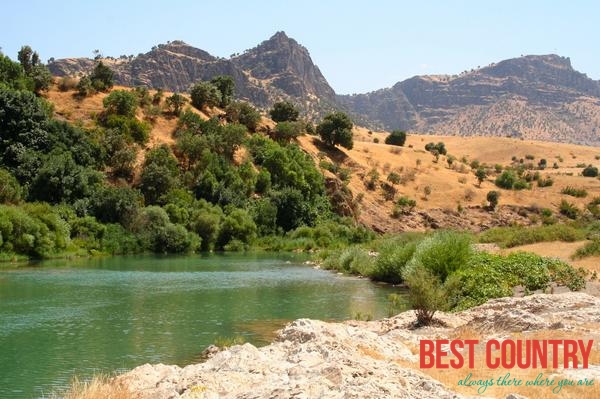Climate of Iraq

Average temperatures in Iraq range from higher than 48 °C (118.4 °F) in July and August to below freezing in January. Most of the rainfall occurs from December through April and averages between 100 and 180 millimeters (3.9 and 7.1 in) annually. The mountainous region of northern Iraq receives appreciably more precipitation than the central or southern desert region.
Roughly 90% of the annual rainfall occurs between November and April, most of it in the winter months from December through March. The remaining six months, particularly the hottest ones of June, July, and August, are dry.
Except in the north and northeast, mean annual rainfall ranges between 100 and 170 millimeters (3.9 and 6.7 in). Data available from stations in the foothills and steppes south and southwest of the mountains suggest mean annual rainfall between 320 and 570 millimeters (12.6 and 22.4 in) for that area. Rainfall in the mountains is more abundant and may reach 1,000 millimeters (39.4 in) a year in some places, but the terrain precludes extensive cultivation. Cultivation on nonirrigated land is limited essentially to the mountain valleys, foothills, and steppes, which have 300 millimeters (11.8 in) or more of rainfall annually. Even in this zone, however, only one crop a year can be grown, and shortages of rain have often led to crop failures.
Mean minimum temperatures in the winter range from near freezing (just before dawn) in the northern and northeastern foothills and the western desert to 2 to 3 °C (35.6 to 37.4 °F) and 4 to 5 °C (39.2 to 41 °F) in the alluvial plains of southern Iraq. They rise to a mean maximum of about 16 °C (60.8 °F) in the western desert and the northeast, and 17 °C (62.6 °F) in the south. In the summer mean minimum temperatures range from about 27 to 34 °C (80.6 to 93.2 °F) and rise to maximums between roughly 42 and 47 °C (107.6 and 116.6 °F). Temperatures sometimes fall below freezing and have fallen as low as −14 °C (6.8 °F) at Ar Rutbah in the western desert. They are more likely, however, to go over 49 °C (120.2 °F) in the summer months, and several stations have records of over 53 °C (127.4 °F).
The summer months are marked by two kinds of wind phenomena. The southern and southeasterly sharqi, a dry, dusty wind with occasional gusts of 80 kilometers per hour (50 mph), occurs from April to early June and again from late September through November. It may last for a day at the beginning and end of the season but for several days at other times. This wind is often accompanied by violent duststorms that may rise to heights of several thousand meters and close airports for brief periods. From mid-June to mid-September the prevailing wind, called the shamal, is from the north and northwest. It is a steady wind, absent only occasionally during this period. The very dry air brought by this shamal permits intensive sun heating of the land surface, but the breeze has some cooling effect.